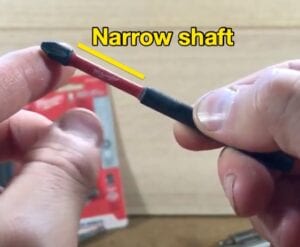There’s a lot of confusion about this topic. So I think it’s a good idea to take the time and give some clarification. But before going straight to the answer, there are some explanations I must make:
Impact Driver Bits vs Regular Drill Bits
We all know the difference between impact drivers and regular drills: torque.
Impact drivers output more power than regular drills for fastening screws. However, most people don’t know the difference between the bits each of these tools use.
Are these bits different at all? The answer is YES.
Let me share with you their differences:
Impact-driver bits are more ductile than regular drill bits
What is ductility? Ductility is, in short, the ability of a metal to change its shape repeatedly. When fastening a screw, the impact driver bit spins at full speed and receives a lot of pressure.
When this happens, if a regular drill bit is used for this, it can easily break as it has much lower ductility than an impact driver bit. On the other hand, as impact-driver bits are more ductile than regular drill bits, they can bend easily without snapping which makes them perfect for those uses.
Impact drill bits have narrow sections

If you put an impact driver bit side by side with a regular drill bit, you’ll see that the impact-driver bit has a narrower shaft than the regular drill bit.
Thanks to its narrower shaft, excess stress is removed from the bit’s tip and released into that shaft which has a larger surface to dissipate the pressure. This design, in turn, allows the impact driver bit to have a much larger torsional strength than a regular drill bit.
As a result, the torsional strength allows the impact driver bit to continue spinning without breaking even when much stress is put on the bit.
On the other hand, the regular drill bit’s design (with a thicker shaft) doesn’t allow the stress to be removed from the bit tip which leads it to have less torsional strength. As a consequence, there’s a higher chance that the regular drill bit will break when using it to drill on tough materials.
Different ends
A big difference between regular and impact driver bits is at their ends.
Regular drill bits usually have rounded ends. This prevents them to be installed in impact drivers as they only work with hex bits. However, some regular drill bits come with hex ends which means these can be installed in most impact drivers.
Should you use regular drill bits in impact drivers? The answer is no. As explained, regular drill bits are not designed to withstand the stress of the torque an impact driver outputs. As a result, if stress-tested, regular drill bits with hex ends placed in impact drivers can easily snap which could also break the impact driver itself.
On the other hand, impact-driver bits have hexagonal ends. This design is thought so that way because impact drivers have hexagonal shanks.
Can You Use Impact Driver Bits In a Regular Drill?

People are very confused about what drill bits to use and what type of drill/driver to use with them.
In this context, a very common question I get is: Can I use impact driver bits in a regular drill? The answer is: yes. In fact, it’s pretty safe to do it. Let me explain:
Regular drills come with chucks responsible for clamping different drill bits. Given their design, chucks can hold both hex drill bits and rounded-ended drill bits. Thus, hex impact driver bits will be compatible with regular drills.
Is it safe?
Given that regular drill bits output lower levels of torque than impact drivers, it’s pretty safe to use impact-driver bits with regular drills. In fact, these bits are engineered to deal with higher levels of stress which makes them even safer to be used with a regular drill.
A different case is using regular drill bits on impact drivers. Given their design and materials, if regular drill bits are used with higher-torque impact drivers this could snap them in pieces and break the impact driver itself.
Why Do Impact Rated Bits Still Break?
Based on what I explained before, one would think impact driver bits don’t break. However, they do.
There are two reasons why impact-driver bits break.
Metal fatigue
As explained, impact driver bits have more ductility than standard drill bits. This attribute lets the bits be more flexible and take more pressure which is essential as they are commonly used to deal with higher-torque impact drivers.
However, these bits are not infinitely flexible. They’re limited by what’s called metal fatigue.
Metal fatigue is what happens when one constantly re-shapes a metal; it comes to a point in which it breaks. This is exactly what happens with impact driver bits. When one uses them many times to fasten hundreds of screws, the bit tips slowly get damages until it comes to a point they’re no longer useful.
Sadly, there are no tips to avoid metal fatigue. It’s an unavoidable consequence of using the bits.
Bit slips
What are bit slips? There are times when one is fastening a screw and the bit slips from the fastener’s head. Those are bit slips.
If this happens repeated times and the quality of the screws are not good the fastener ends up noticeably damaged, right?
What most people don’t know is that these “bit slips” also damage the bits themselves. They do it in a much slower fashion, but they do it. If one is not that good at placing the bit tips on the fastener heads the bits may break.
This is why I recommend that before starting the driver, making sure the bit size is correct for the fastener’s head being fastened and that enough force is applied against the fastener to avoid unwanted slips.
